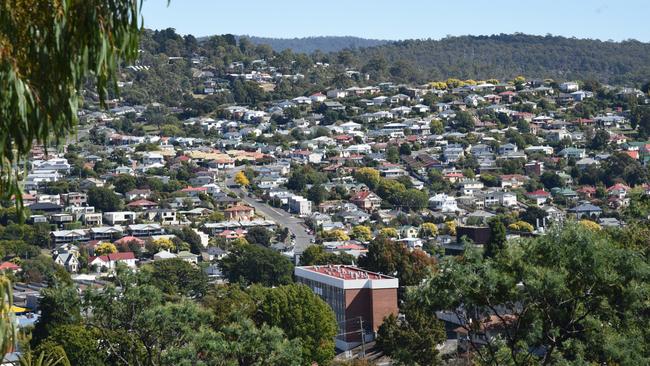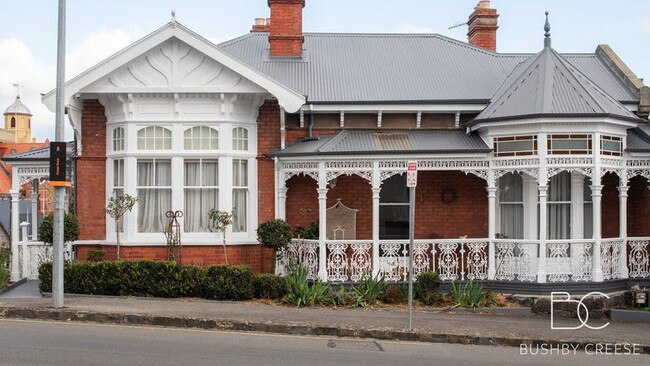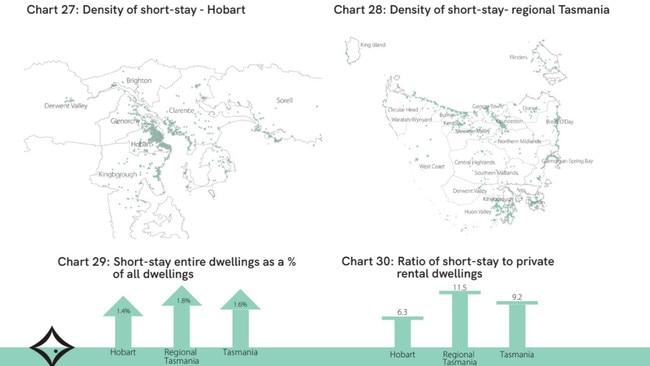Short-stay accommodation Tasmania: Nearly 1-in-10 rentals turned over to Airbnb
A new report has mapped the inexorable rise of the short-stay accommodation market, with a 20 per cent year-on-year growth in the number of entire-dwelling listings. Here are the key takeaways.

Tasmania
Don't miss out on the headlines from Tasmania. Followed categories will be added to My News.
A new report has shed further light on the inexorable rise of the short-stay sector in Tasmania’s housing market, with a 20 per cent year-on-year rise in the number of entire dwellings listed on platforms such as Airbnb.
According to the Real Estate Institute of Australia’s (REIA) latest Short-Stay Accommodation in Australia report, which considers data from the March 2023 quarter, there were 4255 dwellings in Tasmania given over entirely to short-stay accommodation (SSA).
This figure represented a 20.8 per cent year-on-year rise, and 5.2 per cent quarterly rise (December to March).
In Tasmania, 1.6 out of every 100 dwellings are now given over entirely to SSA, while for every 100 private rentals on the market, 9.2 of them are reserved for SSA.
According to the report, SSA takes up a bigger slice of the market in regional Tasmania than it does Hobart. In the capital, only 6.6 out of 100 private rentals are entire-dwelling SSA, while the corresponding figure in the regions is 11.5 out of 100 private rentals.

Hobart has the greatest number of SSA dwellings (819), followed by Glamorgan-Spring Bay (434), Launceston (365) and Kingborough (314).
The fastest growing regions for number of new SSA listings between March 2022 and March 2023 are Clarence (32.4 p.c.), Launceston (25.9 p.c.) and Hobart (24.8 p.c.).
According to the report, a two-bedroom dwelling listed as SSA in Hobart would need to be occupied for 103 nights of the year to deliver the same return as the dwelling would if listed as a private rental ($23,500). The corresponding figure in the state’s regions is 96 nights ($20,300).

REIA president Hayden Groves, in his report preamble, said that SSA had come under “particular scrutiny” in 2023 in light of Australia’s buckling rental market characterised by a yawning gap between supply and demand.
“On one hand, SSA has been an essential part of meeting high demand for domestic tourism
accommodation. At the same time has come under fire for eating into long term rental housing
and being a driving factor behind the rental crisis,” he said.

In Tasmania, tourism accounts for about 15 per cent of employment, and contributes about nine per cent to the gross state product.
And according to a 2020 study commissioned by Airbnb itself, cited in the REIA report, the platform supported approximately 90,000 Australian jobs in 2019 and added $10.38bn to the country’s GDP.
The REIA report canvassed two options for policymakers to explore, if they decided they wanted to restrict the occurrence of entire dwellings becoming reserved for SSA: imposing caps on the number of nights the property could be booked, and levying annual fees, the proceeds of which would be spent on increasing housing supply.
Earlier this year, Hobart City Council elected to double rates for owners of entire-dwelling SSA.
The City of Launceston’s chief executive, Michael Stretton, has previously voiced his belief that the impact of SSA on his city’s rental market was overstated.
He said by far the greatest factor driving down rental vacancy rates – in Launceston at least – was the supply of new dwellings failing to keep up with demand driven by population growth and declining average household sizes.
A December 2022 report by Shelter Tasmania found that about 67 per cent of current SSA dwellings in Launceston were formerly long-term rentals, with the corresponding figure for Hobart about 47 per cent.





